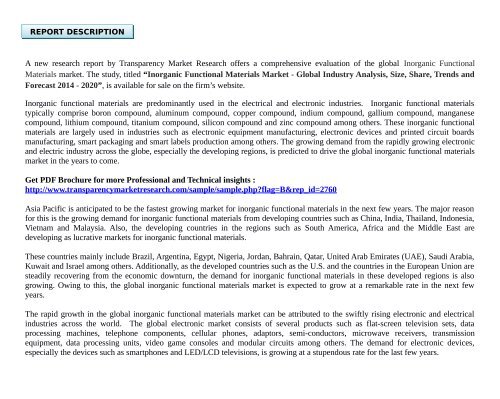Inorganic Functional Materials MarketInorganic Functional Materials Market -Size,Share,Trends and Forecast 2014-2020
The rapid growth in the global inorganic functional materials market can be attributed to the swiftly rising electronic and electrical industries across the world.The global inorganic functional materials market is expected to witness a momentous growth in the next few years.
The rapid growth in the global inorganic functional materials market can be attributed to the swiftly rising electronic and electrical industries across the world.The global inorganic functional materials market is expected to witness a momentous growth in the next few years.
Create successful ePaper yourself
Turn your PDF publications into a flip-book with our unique Google optimized e-Paper software.
REPORT DESCRIPTION<br />
A new research report by Transparency <strong>Market</strong> Research offers a comprehensive evaluation of the global <strong>Inorganic</strong> <strong>Functional</strong><br />
<strong>Materials</strong> market. The study, titled “<strong>Inorganic</strong> <strong>Functional</strong> <strong>Materials</strong> <strong>Market</strong> - Global Industry Analysis, <strong>Size</strong>, <strong>Share</strong>, <strong>Trends</strong> <strong>and</strong><br />
<strong>Forecast</strong> <strong>2014</strong> - <strong>2020</strong>”, is available for sale on the firm’s website.<br />
<strong>Inorganic</strong> functional materials are predominantly used in the electrical <strong>and</strong> electronic industries. <strong>Inorganic</strong> functional materials<br />
typically comprise boron compound, aluminum compound, copper compound, indium compound, gallium compound, manganese<br />
compound, lithium compound, titanium compound, silicon compound <strong>and</strong> zinc compound among others. These inorganic functional<br />
materials are largely used in industries such as electronic equipment manufacturing, electronic devices <strong>and</strong> printed circuit boards<br />
manufacturing, smart packaging <strong>and</strong> smart labels production among others. The growing dem<strong>and</strong> from the rapidly growing electronic<br />
<strong>and</strong> electric industry across the globe, especially the developing regions, is predicted to drive the global inorganic functional materials<br />
market in the years to come.<br />
Get PDF Brochure for more Professional <strong>and</strong> Technical insights :<br />
http://www.transparencymarketresearch.com/sample/sample.php?flag=B&rep_id=2760<br />
Asia Pacific is anticipated to be the fastest growing market for inorganic functional materials in the next few years. The major reason<br />
for this is the growing dem<strong>and</strong> for inorganic functional materials from developing countries such as China, India, Thail<strong>and</strong>, Indonesia,<br />
Vietnam <strong>and</strong> Malaysia. Also, the developing countries in the regions such as South America, Africa <strong>and</strong> the Middle East are<br />
developing as lucrative markets for inorganic functional materials.<br />
These countries mainly include Brazil, Argentina, Egypt, Nigeria, Jordan, Bahrain, Qatar, United Arab Emirates (UAE), Saudi Arabia,<br />
Kuwait <strong>and</strong> Israel among others. Additionally, as the developed countries such as the U.S. <strong>and</strong> the countries in the European Union are<br />
steadily recovering from the economic downturn, the dem<strong>and</strong> for inorganic functional materials in these developed regions is also<br />
growing. Owing to this, the global inorganic functional materials market is expected to grow at a remarkable rate in the next few<br />
years.<br />
The rapid growth in the global inorganic functional materials market can be attributed to the swiftly rising electronic <strong>and</strong> electrical<br />
industries across the world. The global electronic market consists of several products such as flat-screen television sets, data<br />
processing machines, telephone components, cellular phones, adaptors, semi-conductors, microwave receivers, transmission<br />
equipment, data processing units, video game consoles <strong>and</strong> modular circuits among others. The dem<strong>and</strong> for electronic devices,<br />
especially the devices such as smartphones <strong>and</strong> LED/LCD televisions, is growing at a stupendous rate for the last few years.

















